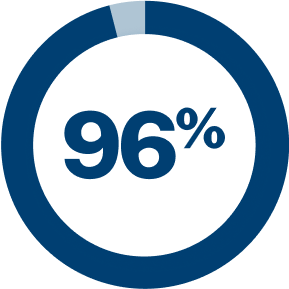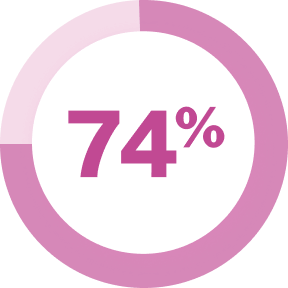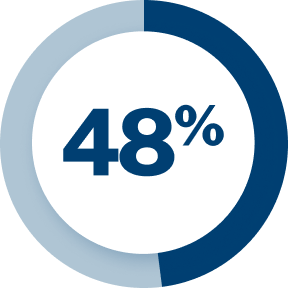Relief shouldn’t require the emergency room
Headache is the fourth most common reason for emergency department visits.
But the ER is often the last place you want to be during an attack1,2:

Migraine attacks are often worsened by bright lights, loud sounds, and strong smells—all common triggers found in emergency rooms.3

Cluster headache attacks are often misdiagnosed in emergency settings and may be mistaken for less severe conditions. Because they can last between 15 minutes to 3 hours, the attack may be over before a patient is seen.4,5

DID YOU KNOW?
Cluster headache is a type of primary headache disease that causes repeated attacks of sudden, severe pain, usually around one eye or on one side of the head. It’s often described as one of the most painful conditions a person can experience.6
Migraine affects an estimated 40 million adults in the U.S.7
40% of patients with migraine reported dissatisfaction with their treatment8,9,*
*According to a survey of 183 patients from 3 headache centers8,9
MIGRAINES

of patients reported their current treatment isn’t meeting all their needs10

reported their treatment wasn’t working well enough to manage their symptoms10

reported they experienced another migraine within 24 hours of initial treatment10

of patients reported not experiencing complete pain relief within two hours10
Data collected as part of the MAST Study, a web-based study of 15,133 U.S. adults from 2016-2017 who met migraine symptom criteria and experienced 1 or more recent attacks.10
Cluster Headache: A painful, underrecognized disorder11


>6 years from symptom onset to diagnosis13

~4 physicians seen before cluster headache diagnosis is reached13

~4 incorrect diagnoses13
The low incidence and frequent misdiagnosis of this condition can have a lasting impact on quality of life. It’s reported that 17% of people affected have lost their jobs and 8% are unemployed due to this disease.† The pain can be so intense that cluster headache is sometimes referred to as the “suicide headache”, with some individuals reporting suicidal thoughts.11,14,†
Cluster headache may be misdiagnosed as migraine6,15,16
KEY DIFFERENCES6,15-24:
Cluster Headache | Migraine |
|
|---|---|---|
| Location of Pain | On one side of the head6 | On one side of the head or on both sides |
| Type of Pain | Piercing pain in/around the eye18,19 | Throbbing or pulsing pain17,19,20 |
| Pain Severity | Severe, excruciating pain11 | Moderate-to-severe pain; often varies during the attack21,22 |
| Symptoms | Excessive tearing, eye redness, pale or flushed skin, on affected side:
|
|
| Duration | Can be from 15 minutes to 3 hours6 | Can be from 4 hours to 3 days17 |
| Event
Frequency | From 1 attack every other day to up to 8 per day6 | Typically just a single attack per day22 |
| Behavioral manifestation | Patients may pace and become agitated or restless6,19,22 | Patients seek rest in a quiet, dark room19,22 |
In the U.S. alone, cluster headache patients had significantly more medical visits than their peers:
More than four times as many ER visits25
Brekiya autoinjector provides patients the same powerful medication used in hospitals8,26
< PREVIOUS PAGE
NEXT PAGE >
Expand
Collapse
Serious or potentially life-threatening reductions in blood flow to the brain or extremities due to interactions between dihydroergotamine (the active ingredient in Brekiya autoinjector) with strong CYP3A4 inhibitors (such as protease inhibitors and macrolide antibiotics) have been reported rarely. As a result, these medications should not be taken together.
- are taking medicines known as strong CYP3A4 inhibitors, such as: ritonavir, nelfinavir, indinavir, erythromycin, clarithromycin, ketoconazole, or itraconazole.
- have heart problems or a history of heart problems, or uncontrolled high blood pressure.
- have narrowing of blood vessels in your legs, arms, stomach, or kidneys (peripheral vascular disease).
- have sepsis, had vascular surgery, severe liver or kidney problems.
- are allergic to dihydroergotamine, ergot alkaloids, latex, or any of the ingredients in Brekiya autoinjector.
- have taken any of the following medicines in the last 24 hours: sumatriptan, frovatriptan, ergotamine or ergotamine-type medicines, almotriptan, naratriptan, zolmitriptan, eletriptan, or rizatriptan
- have taken any medicines that constrict your blood vessels or raise your blood pressure.
- have high blood pressure, liver problems, or kidney problems.
- have risk factors for heart disease, such as: high blood pressure, high cholesterol levels, smoke, are overweight, diabetes, family history of heart disease.
- are pregnant or plan to become pregnant. Brekiya autoinjector may cause preterm labor. Brekiya autoinjector should be avoided during pregnancy. Talk to your healthcare provider right away if you are pregnant or want to become pregnant.
- are breastfeeding or plan to breastfeed. Brekiya autoinjector may reduce breast milk supply and pass into your breast milk. Brekiya autoinjector may be harmful to your baby. Do not breastfeed your baby while taking Brekiya autoinjector and for 3 days after you use Brekiya autoinjector. Talk with your healthcare provider about the best way to feed your baby if you take Brekiya autoinjector.
Tell your healthcare provider about all the medicines you take, including prescription and over-the-counter medicines, vitamins, and herbal supplements. Especially tell your healthcare provider if you take: sumatriptan, ergot-type medicine, saquinavir, nefazodone, fluconazole, grapefruit juice, zileuton, nicotine, propranolol or other medicines that can lower your heart rate, any medicines that can increase your blood pressure, selective serotonin reuptake inhibitors. These are not all of the medicines that could affect how Brekiya autoinjector works. Your healthcare provider can tell you if it is safe to take Brekiya autoinjector with other medicines.
How should I use Brekiya autoinjector?
- Certain people should take their first dose of Brekiya autoinjector in their healthcare provider’s office or in another medical setting.
- Brekiya autoinjector is for injection under the skin (subcutaneous) only.
- Use Brekiya autoinjector exactly as your healthcare provider tells you to use it.
- Each autoinjector contains one dose (1 mg).
- If your headache comes back after the first complete dose, you may give yourself up to 2 more doses as needed. Wait at least one hour between doses.
- Do not inject more than 3 doses (3 mg) of Brekiya autoinjector in a 24‑hour period or 6 doses (6 mg) in a 1‑week (7 day) period.
What are the possible side effects of Brekiya autoinjector?
Brekiya autoinjector can cause serious side effects, including:
- Heart attack and other heart problems. Heart problems may lead to death. Stop taking Brekiya autoinjector and get emergency medical help right away if you have any symptoms of a heart attack, such as: numbness or tingling in your fingers and toes, muscle pain or cramps in your arms and legs, weakness in your legs, temporary speeding or slowing of your heart rate, or swelling or itching. Brekiya autoinjector is not for people with risk factors for heart disease unless a heart exam is done and shows no problem.
- Stroke. Stop using Brekiya autoinjector and get emergency medical help right away if you have any of the symptoms of a stroke.
- Changes in color or sensation in your fingers and toes (Raynaud’s syndrome).
- Stomach and intestinal problems.
- Increased blood pressure.
- Medicine overuse headache. Some people who use too much Brekiya autoinjector may make their headaches worse. If your headaches get worse, your healthcare provider may decide to stop your treatment with Brekiya autoinjector.
- Preterm labor.
- Tissue changes (fibrotic complications). Inflammation and fiber-like tissue that is not normal (fibrosis) can occur around the lungs and stomach.
Tell your healthcare provider if you have any side effect that bothers you or that does not go away. These are not all of the possible side effects of Brekiya autoinjector. Call your healthcare provider for medical advice about side effects.
- Store at room temperature between 68°F to 77°F (20°C to 25°C). Do not refrigerate or freeze.
- Protect Brekiya autoinjector from light.
- Keep Brekiya autoinjector in the original pack until ready to use.
Brekiya autoinjector is not used to prevent migraine or used to treat other types of headaches such as hemiplegic migraines (that make you unable to move on one side of your body) or basilar migraines (rare form of migraine with aura). It is not known if Brekiya autoinjector is safe and effective in children.
To report SUSPECTED ADVERSE REACTIONS, contact Amneal Specialty, a division of Amneal Pharmaceuticals LLC at 1‑877‑835‑5472, or FDA at 1‑800‑FDA‑1088 or www.fda.gov/